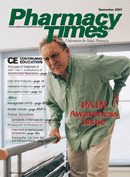Publication
Article
Pharmacy Times
Prescription-overdose Deaths Surpass Car-accident Deaths
Author(s):
John Burke, commander of the Warren County, Ohio, drug task force and retired commander of the Cincinnati Police Pharmaceutical Diversion Squad, is a 39-year veteran of law enforcement. Cmdr Burke also is the current president of the National Association of Drug Diversion Investigators. For information, he can be reached by e-mail at burke@choice.net, via the Web site www.rxdiversion.com, or by phone at 513-336-0070.
Officials in Utah recently reportedthat, in 2006, the deaths attributableto prescription-drugabuse surpassed those deaths thatresulted from auto accidents in the stateduring the same time period. In this timeperiod, 476 drug-related deaths occurred,with 307 of those involving prescriptiondrugs. During this same time, 274 peoplelost their lives due to traffic accidents.Utah is putting together a task force tolook at the problem and hopefully findsolutions for its reduction.
Not surprisingly, oxycodone, hydrocodone,methadone, morphine, and fentanylwere the most commonly found substancesrelated to the prescription-drugabusedeaths in Utah. Also not surprisingis the fact that the deaths were morecommon when multiple substances weremixed, making it more difficult to determinewhich particular pharmaceuticalsubstance contributed most to the death.
This kind of revelation actually is notnew and not surprising, as prescriptiondrugabuse is either rising or just gettingthe kind of attention it has deserved forthe past few decades, or both. Somestates have reported that the number ofoverdose deaths relating to prescriptiondrugs equals more than heroin andcocaine overdose deaths combined. Thisfact also is a staggering thought, exceptwhen you see the results of surveys andother studies that strongly indicate thatprescription-drug abuse ranks secondonly to marijuana abuse, and cocaineabuse is less than half that of the pharmaceuticals.
I applaud officials in Utah for trying todo something about their prescriptiondrugproblem, instead of burying theirheads in the sand, as has been the casewith this issue for many years in theUnited States. Individual states need tolook at their statistics and develop a planto reduce prescription-drug abuse. Thisplan may include seriously considering aprescription-monitoring program, examiningcurrent prescription-drug criminalstatutes, allowing law enforcement moreresources to fight these crimes, andencouraging health professionals, lawenforcement, and regulators to work thisproblem out together.
States also should consider 2 othercomponents?rehabilitation and education/prevention. Without these 2 components,attacking the prescription-drug-abuseproblem will only become a continualrevolving door and very little will beaccomplished. The education componentapplies to everyone?health professionals,law enforcement, everyday citizens,addicts, and the people who consumethe most of these drugs, by far?the legitimate patients.
We seem to be spending far too muchtime blaming each other on this issue,pointing the proverbial finger at the?other side,? whoever that may be. Thepolice blame the physicians for writingtoo much, the physicians blame thepolice for wanting to tell them how topractice medicine; they both blame thepharmaceutical companies for onlywanting to make money; and the politiciansusually say whatever they think willget them elected. In the end, I fear thatthe legitimate patient ends up suffering,and the real problem of pharmaceuticalabuse does not get properly addressed.
The right path to reducing drug diversionin America has not changed much; itstill requires collaboration betweenmany entities that include government,health professionals, private industry,and the concerned public if it is going towork. Getting together and finding solutions,as they seem to be doing in Utah,rather than finger-pointing, is the way toget it done.







